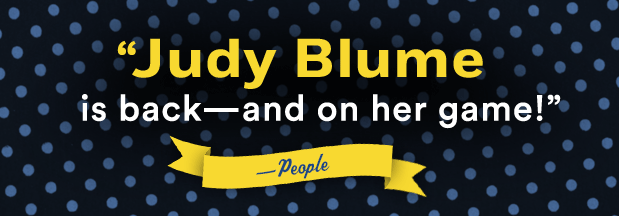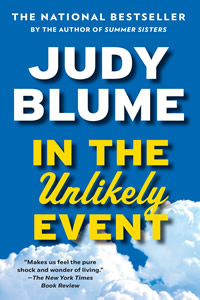Follow the In The Unlikely Event blog on Tumblr.
http://judyblumeofficial.tumblr.com
I'll post it here, too.
#1 - Unforgettable
#2 - (It's No) Sin
#3 - I'll See You In My Dreams
#4 - Get Happy
#5 - Because of You
#6 - How High The Moon
#7 - Fly Me To The Moon
More coming soon...
 May 3 --
May 3 --
Welcome to the fifties. Welcome to the world I lived in when I was a young teenager. It's a lot more than saddle shoes, circle skirts, and Nat King Cole singing unforgettable songs, though growing up to Nat King Cole's music was pretty great. This is Miri Ammerman's world, too -- a world where she is falling in love for the first time against a background of secrets and disasters. Miri doesn't know what's coming, nor does her young and beautiful mother, Rusty. I'll be talking more about the characters and the story, but for now, this is just to put you in the mood.
![]()
 May 4 --
May 4 --
No, this isn’t a Russian novel (or even an Italian one) but there are a lot of characters introduced all at once. You’ll get to know them quickly and eventually they’ll all come together (that’s a promise) but in the meantime, you won’t have to make your own chart as one reader made for me. (You’ll see it at the end of the video.)
![]()
 May 5 --
May 5 --
The main story begins just before Christmas, 1951, with the lighting of the Christmas tree at Rockefeller Center, the first time the ceremony is televised. Miri is invited to join her best friend, Natalie Osner and her family, for a day trip to New York to view the tree, have lunch at Lindy’s, and see the new movie, I’ll See You in My Dreams, starring Doris Day and Danny Thomas, playing at Radio City Music Hall. This is the season to give Volupte compacts to the women in your life, or Lanz nightgowns, or maybe a new book purchased at the Ritz book shop in downtown Elizabeth, NJ.
Here’s a look at Fred, too, a major character in the story, and the kaleidoscope that becomes a treasured gift. Underneath the happy outing, there is growing doubt and fear, but that’s not something any adult is going to talk about in front of the children, leaving the kids to come up with their own explanations.
![]()
 May 6 --
May 6 --
This is Natalie's song.
The message for the kids in the book is get happy, be happy, stay happy, no matter what -- not unlike the message my mother sent me. Be happy, be good, don't give us any trouble.
Natalie Osner wants to be a dancer. She's pretty good. Her tap teacher says she's ready to study in New York. She'd like to be as famous as movie star Ann Miller. She'd like to be the next Ruby Granik, a young dancer on her way to stardom. She's willing to do whatever it takes. But for Natalie, coping with disaster takes a dark turn. Never mind stories in the news about Communists, or spies, or even flying saucers. Never mind what's going on in her school, or at her home, or in her town. She doesn't want to think about any of that. Something else is in her head and it won't leave her alone. Miri will understand if she's still Natalie's best friend. And if she doesn't -- too bad.
Natalie has her own plan.
![]()
 May 9 --
May 9 --
This is Christina's Song.
Christina Demetrios represents the third family in the book, after the Ammermans and the Osners. She's a senior in high school. Her mother owns Nia's Lingerie where Christina's bitchy older sister works. Her mother has a nice Greek boy picked out for Christina to marry. But Christina has her own ideas. She and Jack McKittrick have been secretly dating. They spend New Year's Eve, 1952, at the roller rink instead of wasting Jack's money on some fancy place like the Riviera Nightclub. Christina is smart. She could be going off to college in the fall, if only she weren't in the business course at Battin High. No matter. She's been offered a good job with Dr. Osner, the dentist she works for after school and on Saturdays. She doesn't get Dr. O's family. Fancy Mrs. Osner who comes from money, his stuck-up daughter, Natalie, little Fern who everyone finds adorable except Christina. And Steve, their son, who is her age, not that they have anything in common. She relates to Daisy, Dr. O's secretary, who treats Christina with respect. She could learn a lot from Daisy. She's already learned a lot from Jack.
![]()
 May 11 --
May 11 --
Okay, it’s time to talk about the real events that become the background to the story, or maybe not the background exactly, because in some ways there would be no story without these tragedies. But first, you have to get a feeling for the Elizabeth, NJ of 1952. The busy downtown is just minutes from Newark Airport. Flying commercially was relatively new then. You didn’t just fly around the way we do today. I didn’t fly until I was seventeen and then only because my brother was getting married in Houston. But that’s another story.
My parents were born, raised, and lived in Elizabeth their whole lives. My brother and I were born in Elizabeth and went through school there. Elizabeth is a revolutionary town. When we were young we’d joke that George Washington slept (around) here. He certainly slept there. I don’t know about the around part. I lived in a neighborhood where all the streets were named for English poets. My house was on Shelley Avenue. It was just two blocks from my elementary school, also on Shelley. My friends lived on Browning and Byron. The next street over was Keats. No teacher ever pointed this out to us. I’m not sure I knew, until freshman English at college, how strange/interesting this was. I mean, who named these streets? In the book the Osners live on Shelley Avenue. I’ve put them in a big house (not mine) just down the street. Kathy Stein points out to Steve Osner that the streets are named for English poets, which she finds romantic. Steve’s reaction is, Really, English poets?
We had two public high schools, Battin High for girls, Jefferson for boys. When my parents went to high school there was just one, Battin, and they were classmates. We resented having sex-segregated high schools as teenagers. Looking back I’m not sure that going to an all girls school was a bad thing, especially in the fifties.
My father was a dentist (pictured in this video with his longtime secretary and his dental assistant). The character of Dr. O in the book was inspired by my father. The fictional Dr. O makes different life choices. More about that another time.
Janet Memorial Home was the only orphanage in Elizabeth. Today there are no orphanages. Kids go into foster care if their parents die, or there’s no one in the family to take care of them. I’m told it wasn’t a bad place as orphanages go. (But I don’t have any facts to back that up.) The kids who lived there went to public schools with the rest of us.
I wanted to call the book How High the Moon because the song figures throughout the story but when I checked I found so many books with that title I knew I had to give it up. Ditto for Fly Me to the Moon, but that will be my next post…
![]()
 June 13 --
June 13 --
Many of you have asked What’s real and what isn’t? in the book. Also, Who’s real and who isn’t? This video will show what’s real. That is, the three planes that went down in Elizabeth in 58 days during the winter of 1951-1952. The characters in the three families are all fictitious - even the character of Dr. O, who was inspired by my father, is fictitious. Miri, Rusty, Irene, Henry – all imagined. Natalie, Steve, Fern, Corinne – imagined. Christina’s family, imagined. The characters on the planes are all inspired by real people who were on those flights, as were the people on the ground who were killed or injured. Boys from the orphanage did rescue people from the plane that crashed into their playing field. But the character of Mason is imagined. It’s hard to tell you more without spoilers. All the newspaper stories are based on real newspaper stories. In another post I’ll tell you about the real people I’ve met as I’ve traveled around the US and the UK, people who were connected to this story. And yes, I did want to call the book, Fly Me to the Moon, but like How High the Moon, too many others had used those titles. I was definitely in a moon mood while I was writing the first few drafts.
![]()


